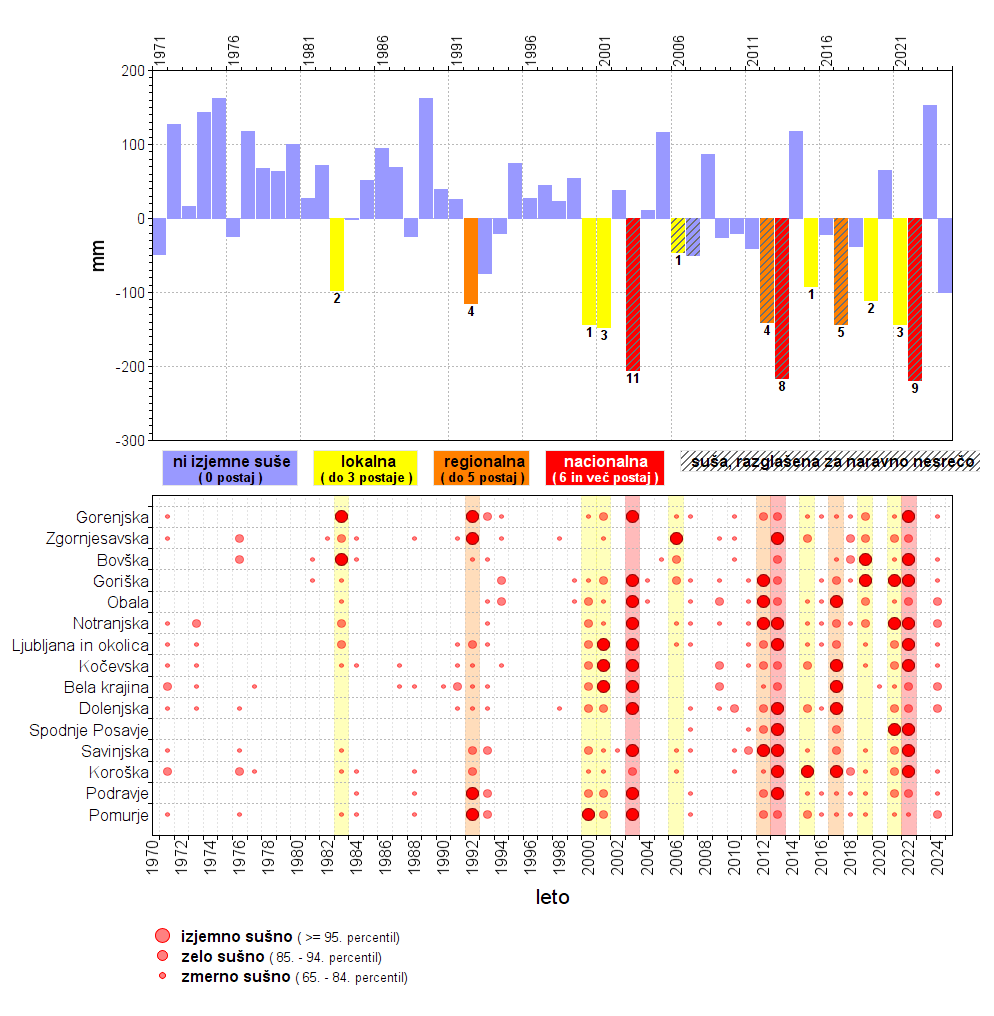[PP14] Agricultural droughts

Key message

The frequency of agricultural drought in Slovenia has been increasing in recent decades. Since year 2000, natural disaster due to drought was declared seven times in Slovenia, the most severe of which occurred in 2003, 2012, 2013, 2017 and 2022. Drought keeps occurring with increasing intensity and in areas and seasons where there have not been problems in the past. An additional risk for drought damage in agriculture present rapidly developing droughts in summer (so-called "flash droughts"), which occur during heat waves. Projections show the continuation of an increasing trend in frequency and intensity of agricultural drought also in future decades.
Charts
Slovenian Environment Agency, 2025
In the upper of the two graphs, the column size corresponds to the values of average summer meteorological water balance for Slovenia for individual years in accordance with the scale on the vertical axis; the number below the column represents the number of regions with extreme drought in the given year; the column colour indicates the spatial extent of extreme drought conditions in Slovenia in accordance with the provided legend; and stripes are added to columns for years when drought was declared a natural disaster on the basis of Natural Disaster Recovery Act. For each year, the number displayed in the upper graph is consistent with the number of extremely dry regions in the lower graph (visualized as large circles). The spatial extent of extreme drought does not necessarily coincide with the column size of the average summer water balance for Slovenia or the government declaration of drought as a national disaster. For example, in 2007 a deficit in average summer water balance is recorded for Slovenia, however it was more or less evenly distributed (as can be seen from the lower of both graphs), so no region experienced a water balance deficit that would exceed 95th percentile of the reference period. An even less pronounced was average summer water balance deficit for Slovenia in 2006, but it was mostly present in one region where it also exceeded 95th percentile and is therefore treated as drought of local extent. The agricultural drought indicator clearly shows concentration of droughts as well as an increase in spatial dimension of extreme droughts since 2000. In that period, drought was most severe in 2003, 2013 and 2022.
Methodology
- ARSO - Agencija RS za okolje, 2017. Ocena tveganja za sušo. MOP-ARSO. (citirano 23. 4. 2021). http://www.meteo.si/uploads/probase/www/agromet/OT/Ocena_tveganja_Susa_DOPOLNJENA_PS.pdf
- ARSO - Agencija RS za okolje, 2018. Ocena podnebnih sprememb v Sloveniji do konca 21. stoletja. Ljubljana, november 2018. Dostopno na:
http://meteo.arso.gov.si/uploads/probase/www/climate/text/sl/publications/OPS21_Porocilo.pdf - European Environment Agency, 2017. Climate change adaptation and disaster risk reduction in Europe (online). Dostopno na naslovu: https://www.eea.europa.eu/publications/climate-change-adaptation-and-disaster
- European Environment Agency, 2021. Water resources across Europe – confronting water stress: an updated assessment (online). Dostopno na naslovu: https://www.eea.europa.eu/en/analysis/publications/water-resources-across-europe-confronting
- Spinoni, J., Naumann, G., Vogt, J. V., Barbosa, P., 2015. The biggest drought events in Europe from 1950 to 2012 (online). Dostopno na naslovu: https://www.sciencedirect.com/science/article/pii/S2214581815000026
- Sušnik, A., 2014. Zasnove kazalcev spremljanja suše na kmetijskih površinah: doktorska disertacija. Ljubljana: Biotehniška fakulteta.
- Sušnik A., Gregorič G., 2017. Kmetijska suša v 21. stoletju v Sloveniji. Ranljivost Slovenije zaradi suše. V: 28. Mišičev vodarski dan 2017, str. 37-44.
- ZOPNN - Zakon o odpravi posledic naravnih nesreč, 2003. Uradni list RS, št. 114/05 – uradno prečiščeno besedilo, 90/07, 102/07, 40/12 – ZUJF, 17/14, 163/22, 18/23 – ZDU-1O, 88/23, 95/23 – ZIUOPZP in 117/23 – ZIUOPZP-A. 35. člen.









